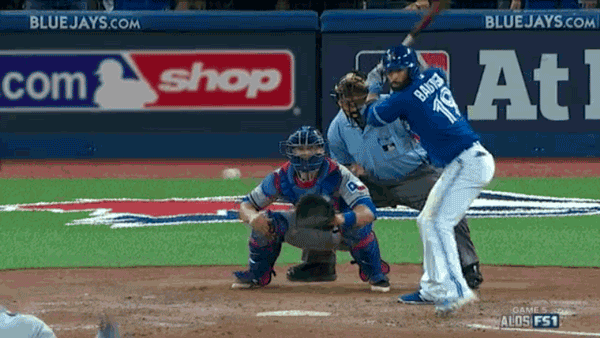There's no crying in baseball, as Tom Hanks says in A League of Their Own. But there is fighting. When it happens, the violence is minimal, the brawl is short-lived and no one sheds a tear. Why is that?
"Baseball fights are highly ritualized cultural behaviour," explains U of A archeologist André Costopoulos. "Everybody involved knows how it works and what to expect."
Costopoulos researches the evolution of social complexity - how our behaviours change over time. He's interested in tracing the way that baseball fights have evolved through the years to exist in their current form. Like any cultural behaviour, he says, baseball fights are predictable because players have learned to perform them through observation and repetition.
So, grab your peanuts and Cracker Jack as Costopoulos takes us out to the ball game for a play-by-play in the evolution of human behaviour.
1: It starts with an ecosystem
Where there's a group of people interacting, there is an ecosystem. Take our city streets, for instance. Drivers, traffic cops and lawmakers all working together to determine the rules of the road - some of which are unwritten. Baseball is its own ecosystem. There are players, coaches, umpires, fans, the front office. Each interacts with the others to influence what behaviour is acceptable. Even if players decide they're in favour of a certain behaviour, punishments levied by officials or fans could mean the behaviour doesn't happen.
2: Inevitably, there's conflict
Ecosystems are dynamic. They're prone to change, which often happens in response to conflict. "In any human endeavour, there is eventually conflict," Costopoulos says. You don't have to look further than a driving commute to see conflict in action. In the early days of organized baseball, the rules didn't deal with all types of conflict. This led to unresolved tension and hostility between players.
3: Tension brings innovations
At some point, a new form of behaviour develops to manage conflict. This is called an innovation. The car horn was originally a safety device. Now, we use it to express anger at other drivers. That's an innovation. In baseball, a frustrated pitcher intentionally throws the ball at a batter; a coach runs on to the field to argue with the umpire; a batter charges a pitcher. These behaviours send a message. "Charging the mound, for example, is a signal to the pitcher not to throw inside," Costopoulos says. "It's meant to affect the game."
4: Some we accept
In cultural evolution terms, an innovation that is replicated by others has fitness. When people see a new behaviour, they decide if it makes sense for their environment. If it does, they try it. This explains the chorus of honking horns during rush hour. It's the same in baseball. The first time somebody charged the mound as sanction for a transgression, other players observed the behaviour and later replicated it. "It was an idea that had fitness in the mental landscape of the players and the observers, so it spread," Costopoulos explains.
5: And some we reject
Some innovations have no fitness. In 1912, notorious Detroit Tiger's outfielder Ty Cobb went into the stands and fought a heckling fan. During a fight in a 1965 game between the San Francisco Giants and the Los Angeles Dodgers, Juan Marichal hit John Roseboro with a bat. These behaviours are isolated, rejected by their ecosystem: Major League Baseball gave those players harsh punishments, and fans and media expressed distaste. "That's part of the calculation of whether or not something gets picked up in the system," Costopoulos says. "There are sanctions and limits."
6: A new ritual takes hold
Once an innovation spreads, it becomes entrenched in the ecosystem; players understand it as common practice. "Baseball fights have evolved into an acceptable way to manage conflict," says Costopoulos. Like any ritual, baseball players understand the triggers of a baseball fight and their roles in it. For example, in 2015 when Blue Jays outfielder José Bautista famously flipped his bat after hitting a homer against the Texas Rangers - violating an unwritten rule of baseball - his teammates knew a fight was brewing.
7: But it's always evolving
Culture changes and baseball fights evolve as players innovate behaviour. Last August, Cincinnati Reds relief pitcher Amir Garrett, in a fit of rage during a tense game, charged off the mound toward the Pittsburgh Pirates dugout to fight the entire opposing team. Media outlets called it "bizarre" and "very entertaining," comparing it to the typical baseball fights. "Charging the dugout, that's an innovation," Costopoulos says. "Is that going to have some fitness? Is it going to spread in the ecosystem? I don't think so, but then again, you never know. Maybe in three years it will be a standard part of the baseball fight."
If you love baseball, check out the 84-hour game that 56 players played recently in Sherwood Park. The goal was to break the Guinness World Record for the world's longest baseball game and raise money for the Cure Cancer Foundation in support of a new drug and therapeutic development at the University of Alberta

We at New Trail welcome your comments. Robust debate and criticism are encouraged, provided it is respectful. We reserve the right to reject comments, images or links that attack ethnicity, nationality, religion, gender or sexual orientation; that include offensive language, threats, spam; are fraudulent or defamatory; infringe on copyright or trademarks; and that just generally aren’t very nice. Discussion is monitored and violation of these guidelines will result in comments being disabled.